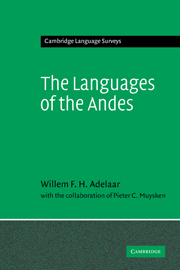Book contents
- Frontmatter
- Contents
- List of tables
- List of maps
- Preface
- Orthographic conventions
- List of abbreviations
- 1 Introduction
- 2 The Chibcha Sphere
- 3 The Inca Sphere
- 4 The languages of the eastern slopes
- 5 The Araucanian Sphere
- 6 The languages of Tierra del Fuego
- 7 The Spanish presence
- Appendix: Inventory of languages and language families of the Andean region
- References
- Author index
- Index of languages and ethnic groups
- Subject index
5 - The Araucanian Sphere
Published online by Cambridge University Press: 22 September 2009
- Frontmatter
- Contents
- List of tables
- List of maps
- Preface
- Orthographic conventions
- List of abbreviations
- 1 Introduction
- 2 The Chibcha Sphere
- 3 The Inca Sphere
- 4 The languages of the eastern slopes
- 5 The Araucanian Sphere
- 6 The languages of Tierra del Fuego
- 7 The Spanish presence
- Appendix: Inventory of languages and language families of the Andean region
- References
- Author index
- Index of languages and ethnic groups
- Subject index
Summary
The term ‘Araucanian Sphere’ has been chosen to cover the central part of what is today the Republic of Chile, extending from the Aconcagua river valley to the island archipelago of Chiloé. At the arrival of the European invaders this area was predominantly inhabited by a single ethnolinguistic group: the Araucanians. This powerful nation became partly incorporated within the colonial society, but also included an important sector which succeeded in preserving its independence until 1882.
In this chapter we furthermore give attention to the central-western part of Argentina, comprising the hilly region known as the Sierra de Córdoba and the Andean foothills region known as Cuyo (including parts of the provinces of Mendoza, San Juan and San Luis). Like the Araucanians, the original inhabitants of central-western Argentina were agriculturalists. They became involved in the process of colonisation right from the beginning, and lost their identity and their languages at an early stage (Martínez Sarasola 1992: 58–63). Of the various native languages that were once spoken in central-western Argentina only the Huarpean languages, Allentiac and Millcayac, have been documented. They constitute a family of closely related languages. Allentiac was spoken in the southern part of San Juan and in northern San Luis, whereas Millcayac extended southward from the culturally important wetlands of Guanacache to the Río Diamante, covering most of Mendoza.
- Type
- Chapter
- Information
- The Languages of the Andes , pp. 502 - 549Publisher: Cambridge University PressPrint publication year: 2004
- 1
- Cited by

